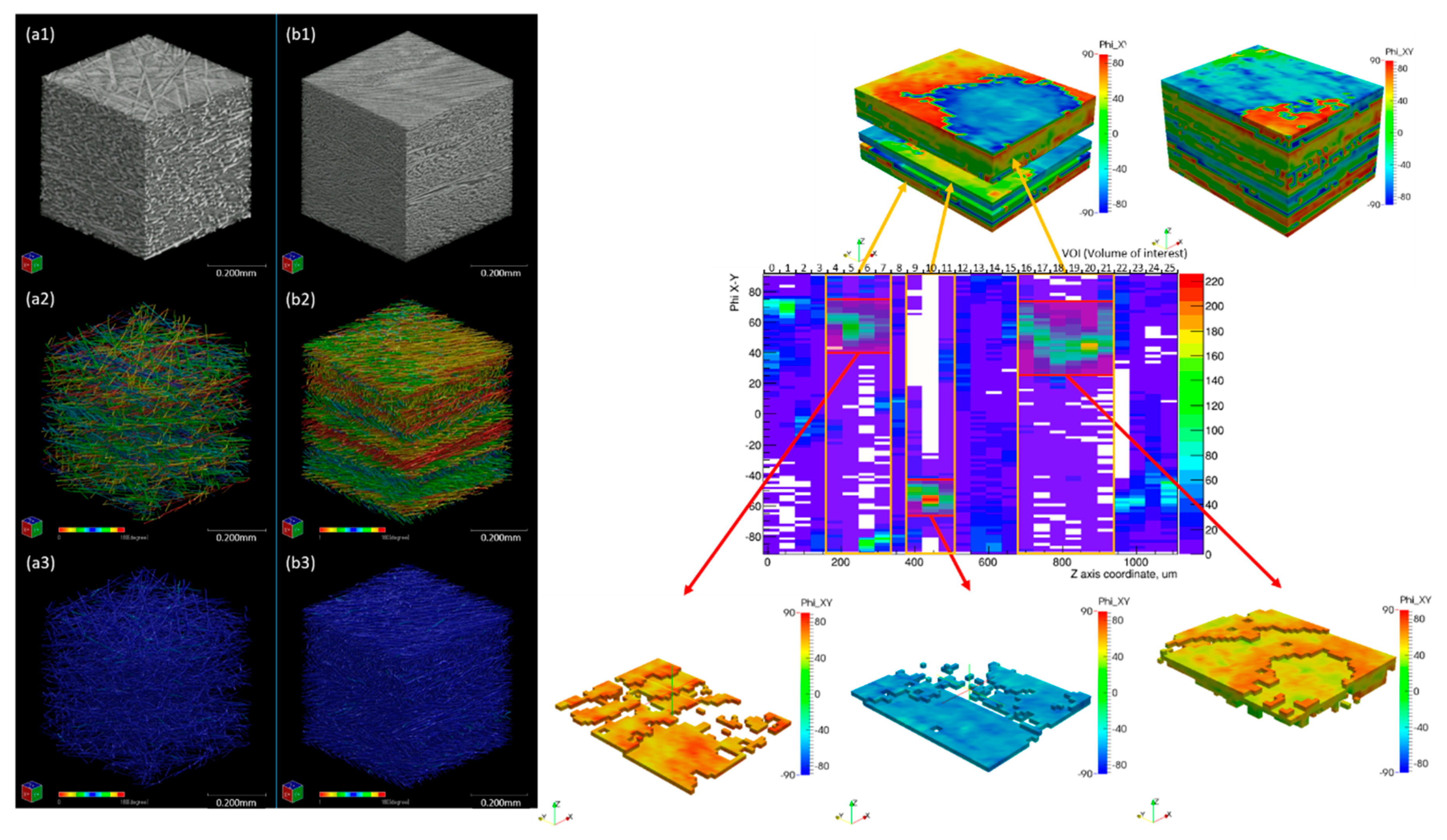Development of Carbon Fiber-Reinforced Thermoplastics for Mass-Produced Automotive Applications in Japan
Abstract
:1. Introduction
2. Specific Requirements for Automotive Applications
3. Technology Developments of the CFRTP Applications
3.1. Overview of Japan’s CFRTP Project at the University of Tokyo
3.2. High Performance of CFRTPs
3.3. Functionality and Recyclability of CFRTP
3.4. Future of CFRTPs in Automotive Applications
4. Conclusions
Author Contributions
Funding
Informed Consent Statement
Data Availability Statement
Acknowledgments
Conflicts of Interest
References
- Henry, A. McLaren: Formula 1 Racing Team; Haynes: Sparkford, Somerset, 1999. [Google Scholar]
- Takahashi, J. Energy Saving Strategy in Transportation by using CFRP. In Proceedings of the Automotive Forum in JEC Paris, Paris, France, 3–5 March 2010. [Google Scholar]
- Takahashi, J. Strategies and technological challenges for realizing lightweight mass production automobile by using thermoplastic CFRP. In Proceedings of the Innovative Composites Summit on JEC Asia, Singapore, Singapore, 29 August 2011. [Google Scholar]
- Ishikawa, T.; Amaoka, K.; Masubuchi, Y.; Yamamoto, T.; Yamanaka, A.; Arai, M.; Takahashi, J. Overview of automotive structural composites technology developments in Japan. Compos. Sci. Technol. 2018, 155, 221–246. [Google Scholar] [CrossRef]
- Takahashi, J. Expectations and challenge of thermoplastic CFRP. In Proceedings of the SAMPE Japan Symposium “Future of Automobile Pioneered by Advanced Materials”, Tokyo, Japan, 2–6 September 2016. [Google Scholar]
- Balakrishnan, V.S.; Seidlitz, H. Potential repair techniques for automotive composites: A review. Compos. Part B Eng. 2018, 145, 28–38. [Google Scholar] [CrossRef]
- Kizaki, T.; Zhang, J.W.; Yao, Q.Y.; Yanagimoto, J. Continuous manufacturing of CFRP sheets by rolling for rapid fabrication of long CFRP products. Compos. Part B Eng. 2020, 189, 10. [Google Scholar] [CrossRef]
- Yao, S.S.; Jin, F.L.; Rhee, K.Y.; Hui, D.; Park, S.J. Recent advances in carbon-fiber-reinforced thermoplastic composites: A review. Compos. Part B Eng. 2018, 142, 241–250. [Google Scholar] [CrossRef]
- Feraboli, P.; Peitso, E.; Cleveland, T.; Stickler, P.B. Modulus Measurement for Prepreg-based Discontinuous Carbon Fiber/Epoxy Systems. J. Compos. Mater. 2009, 43, 1947–1965. [Google Scholar] [CrossRef]
- Feraboli, P.; Peitso, E.; Deleo, F.; Cleveland, T.; Stickler, P.B. Characterization of Prepreg-Based Discontinuous Carbon Fiber/Epoxy Systems. J. Reinf. Plast. Compos. 2009, 28, 1191–1214. [Google Scholar] [CrossRef]
- Feraboli, P.; Cleveland, T.; Ciccu, M.; Stickler, P.; DeOto, L. Defect and damage analysis of advanced discontinuous carbon/epoxy Composite Materials. Compos. Part A Appl. Sci. Manuf. 2010, 41, 888–901. [Google Scholar] [CrossRef]
- Feraboli, P.; Cleveland, T.; Stickler, P.; Halpin, J. Stochastic laminate analogy for simulating the variability in modulus of discontinuous Composite Materials. Compos. Part A Appl. Sci. Manuf. 2010, 41, 557–570. [Google Scholar] [CrossRef]
- Selezneva, M.; Lessard, L. Characterization of mechanical properties of randomly oriented strand thermoplastic composites. J. Compos. Mater. 2016, 50, 2833–2851. [Google Scholar] [CrossRef]
- Selezneva, M.; Roy, S.; Meldrum, S.; Lessard, L.; Yousefpour, A. Modelling of mechanical properties of randomly oriented strand thermoplastic composites. J. Compos. Mater. 2017, 51, 831–845. [Google Scholar] [CrossRef]
- Visweswaraiah, S.B.; Selezneva, M.; Lessard, L.; Hubert, P. Mechanical characterisation and modelling of randomly oriented strand architecture and their hybrids—A general review. J. Reinf. Plast. Compos. 2018, 37, 548–580. [Google Scholar] [CrossRef]
- Li, Y.Z.; Pimenta, S.; Singgih, J.; Nothdurfter, S.; Schuffenhauer, K. Experimental investigation of randomly-oriented tow-based discontinuous composites and their equivalent laminates. Compos. Part A Appl. Sci. Manuf. 2017, 102, 64–75. [Google Scholar] [CrossRef]
- Karakaya, N.; Papila, M.; Ozkoc, G. Overmolded hybrid composites of polyamide-6 on continuous carbon and glass fiber/epoxy composites: ‘An assessment of the interface’. Compos. Part A Appl. Sci. Manuf. 2020, 131, 105771. [Google Scholar] [CrossRef]
- Kasemphaibulsuk, P.; Holzner, M.; Kuboki, T.; Hrymak, A. Foam injection molding of glass fiber reinforced polypropylene composites with laminate skins. Polym. Compos. 2018, 39, 4322–4332. [Google Scholar] [CrossRef]
- Carello, M.; Amirth, N.; Airale, A.G.; Monti, M.; Romeo, A. Building Block Approach’ for Structural Analysis of Thermoplastic Composite Components for Automotive Applications. Appl. Compos. Mater. 2017, 24, 1309–1320. [Google Scholar] [CrossRef]
- Hartley, W.D.; McCann, J.; Davis, S.; Hocker, T.; Bobba, S.; Verghese, N.; Bajaj, D.; Yu, H.Z.; Dillard, D.A. Fracture Characterization of Overmold Composite Adhesion. J. Thermoplast. Compos. 2020. [Google Scholar] [CrossRef]
- Takahashi, J. Development of innovative CFRTP technologies for mass-produced cars. JEC Compos. Mag. 2013, 81, 44–45. [Google Scholar]
- Takahashi, J.; Fujita, M.; Wan, Y. Toward a new generations of composites for our common future—Some activities on CFRTP for automotive applications. In Proceedings of the 15th European-Japanese Meeting on Composite Materials, London, UK, 25–26 September 2017. [Google Scholar]
- Takahashi, J.; Ishikawa, T. Current Japanese Activity in CFRTP for Automotive Application. In Proceedings of the 13th Euro-Japanese Symposium on Composite Materials, Nantes, France, 4–6 November 2013. [Google Scholar]
- Takahashi, J.; Ishikawa, T. Next challenge in CFRTP for mass production automotive application. In Proceedings of the SEICO 14 SAMPE EUROPE 35th International Conference and Forum, Paris, France, 11 March 2014. [Google Scholar]
- Sato, Y.; Takahashi, J.; Matsuo, T.; Ohsawa, I.; Kiriyama, K.; Nago, S. Elastic modulus estimation of chopped carbon fiber tape reinforced thermoplastics using the monte carlo simulation. In Proceedings of the 19th international Conference on Composite Materials, Montréal, QC, Canada, 28 July–2 August 2013; pp. 6718–6725. [Google Scholar]
- Wan, Y.; Takahashi, J. Fiber Length Effect On Tensile And Compressive Strength Of Short Fiber Reinforced Thermoplastics. In Proceedings of the 16th European Conference On Composite Materials, Seville, Spain, 22–26 June 2014. [Google Scholar]
- Wan, Y.; Ohori, T.; Takahashi, J. Mechanical properties and modeling of discontinuous carbon fiber reinforced thermoplastics. In Proceedings of the 20th International Conference on Composite Materials, Copenhagen, Denmark, 19–24 July 2015; pp. 3222–3224. [Google Scholar]
- Wan, Y.; Takahashi, J. Effect of tape length and impregnation conditions on mechanical properties of carbon fiber tape reinforced thermoplastics. In Proceedings of the 12th International Conference on Textile Composites, Raleigh, NC, USA, 26-29 May 2015. [Google Scholar]
- Lyu, X.; Takahashi, J.; Wan, Y. Analysis of viscoelastic behaviour of ultra-thin chopped carbon fiber tape reinforced thermoplastics with different tape lengths. In Proceedings of the 17th European Conference on Composite Materials, Munich, Germany, 26–30 June 2016. [Google Scholar]
- Meng, L.; Wataki, H.; Ohsawa, I.; Takahashi, J. Failure analysis of ultra-thin chopped carbon fiber tape reinforced thermoplastic in mechanical joints. In Proceedings of the 17th European Conference on Composite Materials, Munich, Germany, 26–30 June 2016. [Google Scholar]
- Nakashima, Y.; Suganuma, H.; Yamashita, S.; Takahashi, J. Evaluation of flexural modulus of ultra-thin chopped carbon fiber tape reinforced thermoplastics. In Proceedings of the 17th European Conference on Composite Materials, Munich, Germany, 26–30 June 2016. [Google Scholar]
- Wan, Y.; Takahashi, J. Tensile and compressive properties of chopped carbon fiber tapes reinforced thermoplastics with different fiber lengths and molding pressures. Compos. Part A Appl. Sci. Manuf. 2016, 87, 271–281. [Google Scholar] [CrossRef]
- Wan, Y.; Takahashi, J. Tensile properties and aspect ratio simulation of transversely isotropic discontinuous carbon fiber reinforced thermoplastics. Compos. Sci. Technol. 2016, 137, 167–176. [Google Scholar] [CrossRef]
- Yamashita, S.; Hashimoto, K.; Suganuma, H.; Takahashi, J. Experimental characterization of the tensile failure mode of ultra-thin chopped carbon fiber tape-reinforced thermoplastics. J. Reinf. Plast. Compos. 2016, 35, 1342–1352. [Google Scholar] [CrossRef]
- Lee, H.; Bi, C.; Tang, S.; Hayashi, T.; Takahashi, J. Formability and flow front observation of carbon/polyamide 6 randomly oriented strand composites during compression molding. J. Reinf. Plast. Compos. 2017, 36, 1727–1744. [Google Scholar] [CrossRef]
- Nakashima, Y.; Yamashita, S.; Zhang, X.; Suganuma, H.; Takahashi, J. Analytical modelling of the behaviour and scatter of the flexural modulus of randomly oriented carbon fibre strand thermoplastic composites. Compos. Struct. 2017, 178, 217–224. [Google Scholar] [CrossRef]
- Sato, W.; Shida, R.; Toyoda, H.; Fujita, M.; Takahashi, J. Verification of flexural rigidity of thickness optimized structure made of discontinuous CFRTP. In Proceedings of the 21st International Conference on Composite Materials, Xi’an, China, 20–25 August 2017. [Google Scholar]
- Qu, P.; Wan, Y.; Bao, C.; Sun, Q.; Fang, G.; Takahashi, J. A new numerical method for the mechanical analysis of chopped carbon fiber tape-reinforced thermoplastics. Compos. Struct. 2018, 201, 857–866. [Google Scholar] [CrossRef]
- Meng, L.; Wan, Y.; Ohsawa, I.; Takahashi, J. Effects of geometric parameters on the failure behavior of mechanically fastened chopped carbon fiber tape reinforced thermoplastics. Compos. Struct. 2019, 229, 111475. [Google Scholar] [CrossRef]
- Wan, Y.; Takahashi, J. Mechanical modeling of CF/PA6 sheet molding compounds with X-ray computed tomography-based internal geometry considerations. Compos. Sci. Technol. 2020, 192, 108104. [Google Scholar] [CrossRef]
- Wan, Y.; Takahashi, J.; Ohsawa, I. Investigation about the springback effect on short fiber reinforced thermoplastics. In Proceedings of the 13th Japan International SAMPE Symposium & Exhibition, Nagoya, Japan, 6–8 November 2013. [Google Scholar]
- Wan, Y.; Takahashi, J. Thermal deformation caused by residual stress in short fiber reinforced thermoplastics. In Proceedings of the SEICO 14 SAMPE EUROPE 35th International Conference and Forum, Paris, France, 11 March 2014. [Google Scholar]
- Wan, Y.; Takahashi, J. Deconsolidation behavior of carbon fiber reinforced thermoplastics. J. Reinf. Plast. Compos. 2014, 33, 1613–1624. [Google Scholar] [CrossRef]
- Lee, H.; Ohsawa, I.; Takahashi, J. Effect of plasma surface treatment of recycled carbon fiber on carbon fiber-reinforced plastics (CFRP) interfacial properties. Appl. Surf. Sci. 2015, 328, 241–246. [Google Scholar] [CrossRef]
- Kobayashi, D.; Nakamura, T.; Wan, Y.; Ohsawa, I.; Takahashi, J. A study on hybridization of springbacked carbon fiber reinforced thermoplastics. In Proceedings of the 21st International Conference on Composite Materials, Xi’an, China, 20–25 August 2017. [Google Scholar]
- Zhang, Y.; Wan, Y.; Nakamura, T.; Takahashi, J. Effect of springback ratio on bending and impact property of carbon fiber reinforced thermoplastics sandwich structures. In Proceedings of the 21st International Conference on Composite Materials, Xi’an, China, 20–25 August 2017. [Google Scholar]
- Wei, H.; Nagatsuka, W.; Lee, H.; Ohsawa, I.; Sumimoto, K.; Wan, Y.; Takahashi, J. Mechanical properties of carbon fiber paper reinforced thermoplastics using mixed discontinuous recycled carbon fibers. Adv. Compos. Mater. 2018, 27, 19–34. [Google Scholar] [CrossRef]
- Li, J.; Xiao, B.; Matsuda, H.; Wan, Y.; Ohsawa, I.; Takahashi, J. Flexural property and energy absorption ability of CPT/AWT hybrid composites. In Proceedings of the 16th Japan international SAMPE symposium and exhibition, Tokyo, Japan, 2–6 September 2019. [Google Scholar]
- Matsuda, H.; Xiao, B.; Ohsawa, I.; Takahashi, J. Effect of aramid fiber cloth on carbon/aramid fiber reinforced thermoplastics. In Proceedings of the 22nd international conference on Composite Materials, Melbourne, Australia, 11–16 August 2019. [Google Scholar]
- Wei, H.; Nagatsuka, W.; Ohsawa, I.; Sumimoto, K.; Takahashi, J. Influence of small amount of glass fibers on mechanical properties of discontinuous recycled carbon fiber-reinforced thermoplastics. Adv. Compos. Mater. 2019, 28, 321–334. [Google Scholar] [CrossRef]
- Xiao, B.; Wan, Y.; Ohsawa, I.; Takahashi, J. Effect of needle punching on flexural behavior of carbon fiber-reinforced thermoplastic sandwich panel with spring-backed core. Compos. Part A Appl. Sci. Manuf. 2019, 118, 57–66. [Google Scholar] [CrossRef]
- Wei, H.; Akiyama, T.; Lee, H.; Yamane, M.; Takahashi, J.; Ohsawa, I.; Murakami, T.; Kawabe, K. Recycling of market CFRP/CFRTP waste for mass production application. In Proceedings of the 19th international Conference on Composite Materials, Montréal, QC, Canada, 28 July–2 August 2013; pp. 8574–8581. [Google Scholar]
- Wei, H.; Akiyama, T.; Lee, H.; Ohsawa, I.; Takahashi, J. Mechanical properties of recycled carbon fiber reinforced thermoplastics made by carbon fiber paper. In Proceedings of the 16th European Conference on Composite Materials, Seville, Spain, 22–26 June 2014. [Google Scholar]
- Wei, H.; Lee, H.; Nagatsuka, W.; Ohsawa, I.; Kawabe, K.; Murakami, T.; Sumitomo, T.; Takahashi, J. Systematic comparison between carding and paper-making method for producing discontinuous recycled carbon fiber reinforced thermoplastics. In Proceedings of the 20th International Conference on Composite Materials, Copenhagen, Denmark, 19–24 July 2015; pp. 1–9. [Google Scholar]
- Okano, N.; Wei, H.; Cai, G.; Wada, M.; Kitaoka, S.; Takahashi, J. Influence of recycling condition on the scatter of CFRP properties. In Proceedings of the 21st International Conference on Composite Materials, Xi’an, China, 20–25 August 2017. [Google Scholar]
- Yin, G.; Cai, G.; Wei, H.; Nagatsuka, W.; Kohira, T.; Morisawa, J.; Takahashi, J. Novel carding process to improve mechanical properties of recycled carbon fiber card web reinforced thermoplastics. In Proceedings of the 21st International Conference on Composite Materials, Xi’an, China, 20–25 August 2017. [Google Scholar]
- Zhang, Y.; Yin, G.; Xiao, B.; Wan, Y.; Ohsawa, I.; Takahashi, J. Comparison between springbacked carbon fiber card web reinforced thermoplastics and carbon fiber paper reinforced thermoplastics sandwich structures on bending and impact property. In Proceedings of the 18th European Conference on Composite Materials, Athens, Greece, 25–28 June 2018. [Google Scholar]
- Furuta, Y.; Shao, S.; Yin, G.; Xiao, B.; Wan, Y.; Takahashi, J. Design of semi-complex parts using anisotropic carbon fiber card web reinforced thermoplastics. In Proceedings of the 22nd international conference on Composite Materials, Melbourne, Australia, 11–16 August 2019. [Google Scholar]
- Xiao, B.; Zaima, T.; Shindo, K.; Kohira, T.; Morisawa, J.; Wan, Y.; Yin, G.; Ohsawa, I.; Takahashi, J. Characterization and elastic property modeling of discontinuous carbon fiber reinforced thermoplastics prepared by a carding and stretching system using treated carbon fibers. Compos. Part A Appl. Sci. Manuf. 2019, 126, 105598. [Google Scholar] [CrossRef]
- Wan, Y.; Straumit, I.; Takahashi, J.; Lomov, S.V. Micro-CT analysis of internal geometry of chopped carbon fiber tapes reinforced thermoplastics. Compos. Part A Appl. Sci. Manuf. 2016, 91 Pt 1, 211–221. [Google Scholar] [CrossRef]
- Wan, Y.; Straumit, I.; Takahashi, J.; Lomov, S.V. Micro-CT analysis of the orientation unevenness in randomly chopped strand composites in relation to the strand length. Compos. Struct. 2018, 206, 865–875. [Google Scholar] [CrossRef]
- Yamashita, S.; Ohsawa, I.; Morita, A.; Takahashi, J. Fracture behavior of carbon fiber reinforced polypropylene under artificial lightning strike. In Proceedings of the 19th international Conference on Composite Materials, Montréal, QC, Canada, 28 July–2 August 2013; pp. 6940–6948. [Google Scholar]
- Nagatsuka, W.; Wada, M.; Ohsawa, I.; Kitaoka, S.; Takahashi, J. Influence of Superheated Steam Treatment Condition on Recycled Carbon Fiber. In Proceedings of the 1st International Symposium on Emerging Functional Materials, Songdo, Korea, 4–6 November 2015. [Google Scholar]
- Cai, G.; Yin, G.; Wada, M.; Kitaoka, S.; Wei, H.; Ohsawa, I.; Takahashi, J. Influence of recycling process on the tensile property of carbon fiber. In Proceedings of the 21st International Conference on Composite Materials, Xi’an, China, 20–25 August 2017. [Google Scholar]
- Cai, G.; Wada, M.; Ohsawa, I.; Kitaoka, S.; Takahashi, J. Influence of treatment with superheated steam on tensile properties of carbon fiber. Compos. Part A Appl. Sci. Manuf. 2018, 107, 555–560. [Google Scholar] [CrossRef]
- Cai, G.; Wada, M.; Ohsawa, I.; Kitaoka, S.; Takahashi, J. Interfacial adhesion of recycled carbon fibers to polypropylene resin: Effect of superheated steam on the surface chemical state of carbon fiber. Compos. Part A Appl. Sci. Manuf. 2019, 120, 33–40. [Google Scholar] [CrossRef]
- Cai, G.; Wada, M.; Ohsawa, I.; Kitaoka, S.; Takahashi, J. Tensile properties of recycled carbon fibers subjected to superheated steam treatment under various conditions. Compos. Part A Appl. Sci. Manuf. 2020, 133, 105869. [Google Scholar] [CrossRef]
- Wan, Y.; Matsuo, T.; Ohsawa, I.; Takahashi, J. Effects of curvature on strength and damage modes of L-shaped carbon fiber-reinforced polypropylene. J. Reinf. Plast. Compos. 2014, 33, 1305–1315. [Google Scholar] [CrossRef]
- Matsuo, T.; Goto, T.; Takahashi, J. Investigation about the fracture behavior and strength in a curved section of CF/PP composite by a thin-curved beam specimen. Adv. Compos. Mater. 2015, 24, 249–268. [Google Scholar] [CrossRef]
- Ohori, T.; Hayashi, T.; Takahashi, J. FEA using design optimization technique for an application of carbon fiber reinforced thermoplastics to automobile body structure. In Proceedings of the 20th International Conference on Composite Materials, Copenhagen, Denmark, 19–24 July 2015; pp. 1–10. [Google Scholar]
- Guo, Q.; Li, Z.H.; Ohori, T.; Takahashi, J. Design optimization of CFRP rectangular box subjected to arbitrary loadings. In Proceedings of the 17th European Conference on Composite Materials, Munich, Germany, 26–30 June 2016. [Google Scholar]
- Fujita, M.; Nakashima, Y.; Takahashi, J. Influence of strand dispersion method on mechanical properties of hollow-S-shaped member made of randomly-orientated CFRTP strands. In Proceedings of the 21st International Conference on Composite Materials, Xi’an, China, 20–25 August 2017. [Google Scholar]
- Shida, R.; Takahashi, J. Theoretical analysis on CFRTP optimal structure subjected to bending load and the influence of out-of-plane shear modulus. In Proceedings of the 21st International Conference on Composite Materials, Xi’an, China, 20–25 August 2017. [Google Scholar]
- Toyoda, H.; Suganuma, H.; Yamashita, S.; Hayashi, T.; Fujita, M.; Takahashi, J. Influence of strand dimension and dispersion method on rigidity and its scatter of hat shaped specimens made of randomly-oriented CFRTP strands. In Proceedings of the 21st International Conference on Composite Materials, Xi’an, China, 20–25 August 2017. [Google Scholar]
- Guo, Q.; Ohsawa, I.; Takahashi, J. L-shaped structures made from ultrathin chopped carbon fiber tape reinforced thermoplastics: Delamination behavior and optimization. Adv. Compos. Mater. 2019, 28, 479–489. [Google Scholar] [CrossRef]
- Guo, Q.; Ohsawa, I.; Takahashi, J. Experimental and Numerical Investigation of Mode I and Mode II Interlaminar Behavior of Ultra-Thin Chopped Carbon Fiber Tape-Reinforced Thermoplastics. Arab. J. Sci. Eng. 2020, 45, 1071–1080. [Google Scholar] [CrossRef]
- Guo, Q.; Xiao, B.; Ohsawa, I.; Takahashi, J. Fracture mechanism characteristics of ultra-thin chopped carbon fiber tape-reinforced thermoplastics hat-shaped hollow beam under transverse static and impact loadings. Carbon Lett. 2020, 30, 271–280. [Google Scholar] [CrossRef]
- Mittal, G.; Rhee, K.Y.; Miskovic-Stankovic, V.; Hui, D. Reinforcements in multi-scale polymer composites: Processing, properties, and applications. Compos. Part B Eng. 2018, 138, 122–139. [Google Scholar] [CrossRef]
- Lyu, X.; Ohsawa, I.; Takahashi, J. Applicability of a tapping method to non-destructive inspection of carbon fiber reinforced thermoplastics. In Proceedings of the 20th International Conference on Composite Materials, Copenhagen, Denmark, 19–24 July 2015; pp. 1–12. [Google Scholar]
- Yamashita, S.; Nakashima, Y.; Takahashi, J.; Kawabe, K.; Murakami, T. Tape length dependence of the electrical conductivity of ultra-thin chopped carbon fiber tape reinforced thermoplastics. In Proceedings of the 14th Japan International SAMPE Symposium and Exhibition, Kanazawa, Japan, 6–9 December 2015. [Google Scholar]
- Yamashita, S.; Nakashima, Y.; Takahashi, J.; Kawabe, K.; Murakami, T. Volume resistivity of ultra-thin chopped carbon fiber tape reinforced thermoplastics. Compos. Part A Appl. Sci. Manuf. 2016, 90, 598–605. [Google Scholar] [CrossRef]
- Hayashi, T.; Kobayashi, T.; Takahashi, J. Quantification of the void content of Composite Materials using soft X-ray transmittance. J. Thermoplast. Compos. 2017, 30, 1522–1540. [Google Scholar] [CrossRef]
- Yamashita, S.; Sonehara, T.; Takahashi, J.; Kawabe, K.; Murakami, T. Effect of thin-ply on damage behaviour of continuous and discontinuous carbon fibre reinforced thermoplastics subjected to simulated lightning strike. Compos. Part A Appl. Sci. Manuf. 2017, 95, 132–140. [Google Scholar] [CrossRef]
- Lyu, X.; Takahashi, J.; Wan, Y.; Ohsawa, I. Determination of transverse flexural and shear moduli of chopped carbon fiber tape-reinforced thermoplastic by vibration. J. Compos. Mater. 2018, 52, 395–404. [Google Scholar] [CrossRef]
- Lyu, X.; Wan, Y.; Takahashi, J.; Ohsawa, I. Health condition evaluation of carbon fiber–reinforced thermoplastic with a tapping system. J. Thermoplast. Compos. 2018, 31, 959–973. [Google Scholar] [CrossRef]
- Toyoda, H.; Sato, W.; Takahashi, J. Effect of thermal welding repair for damaged ultrathin chopped carbon fiber tape reinforced thermoplastics. In Proceedings of the 18th European Conference on Composite Materials, Athens, Greece, 25–28 June 2018. [Google Scholar]
- Piao, H.; Chen, L.; Kiryu, Y.; Ohsawa, I.; Takahashi, J. Influence of Water Absorption and Temperature on the Mechanical Properties of Discontinuous Carbon Fiber Reinforced Polyamide 6. Fibers Polym. 2019, 20, 611–619. [Google Scholar] [CrossRef]
- Piao, H.; Kiryu, Y.; Chen, L.; Yamashita, S.; Ohsawa, I.; Takahashi, J. Influence of water absorption on the mechanical properties of discontinuous carbon fiber reinforced polyamide 6. J. Polym. Res. 2019, 26, 63. [Google Scholar] [CrossRef]
- Zhang, J.; Chevali, V.S.; Wang, H.; Wang, C.H. Current status of carbon fibre and carbon fibre composites recycling. Compos. Part B Eng. 2020, 193, 15. [Google Scholar] [CrossRef]
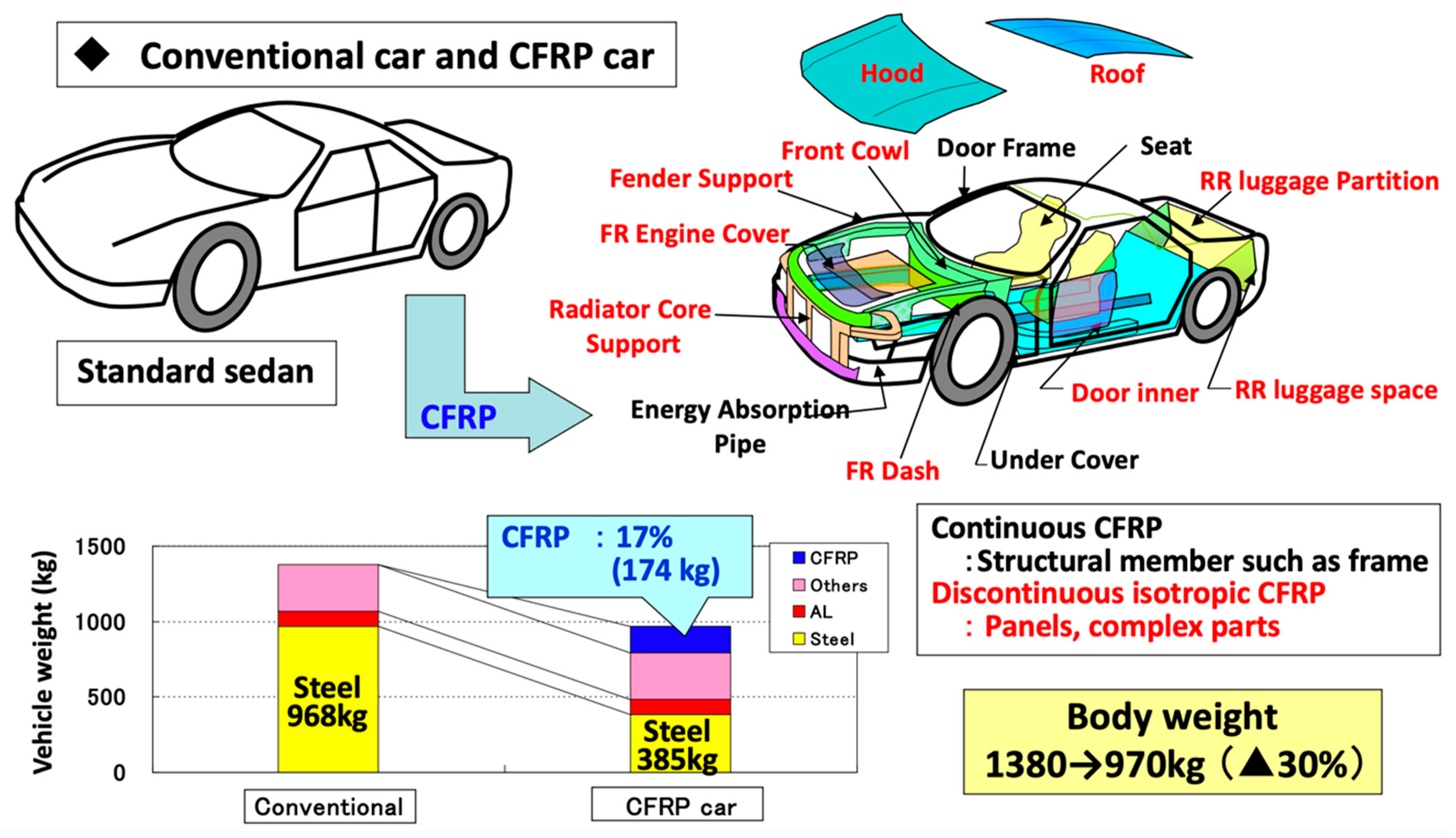
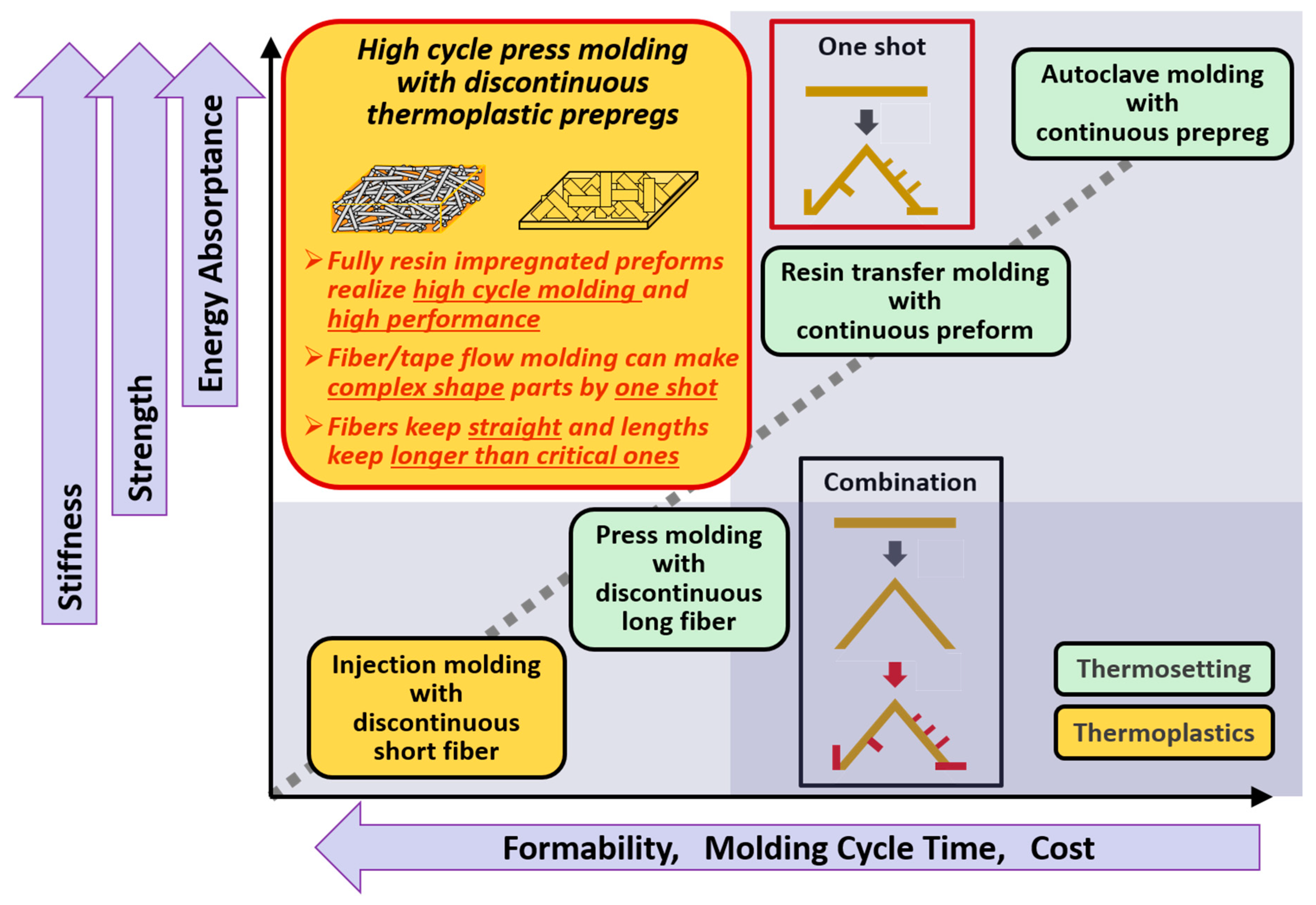


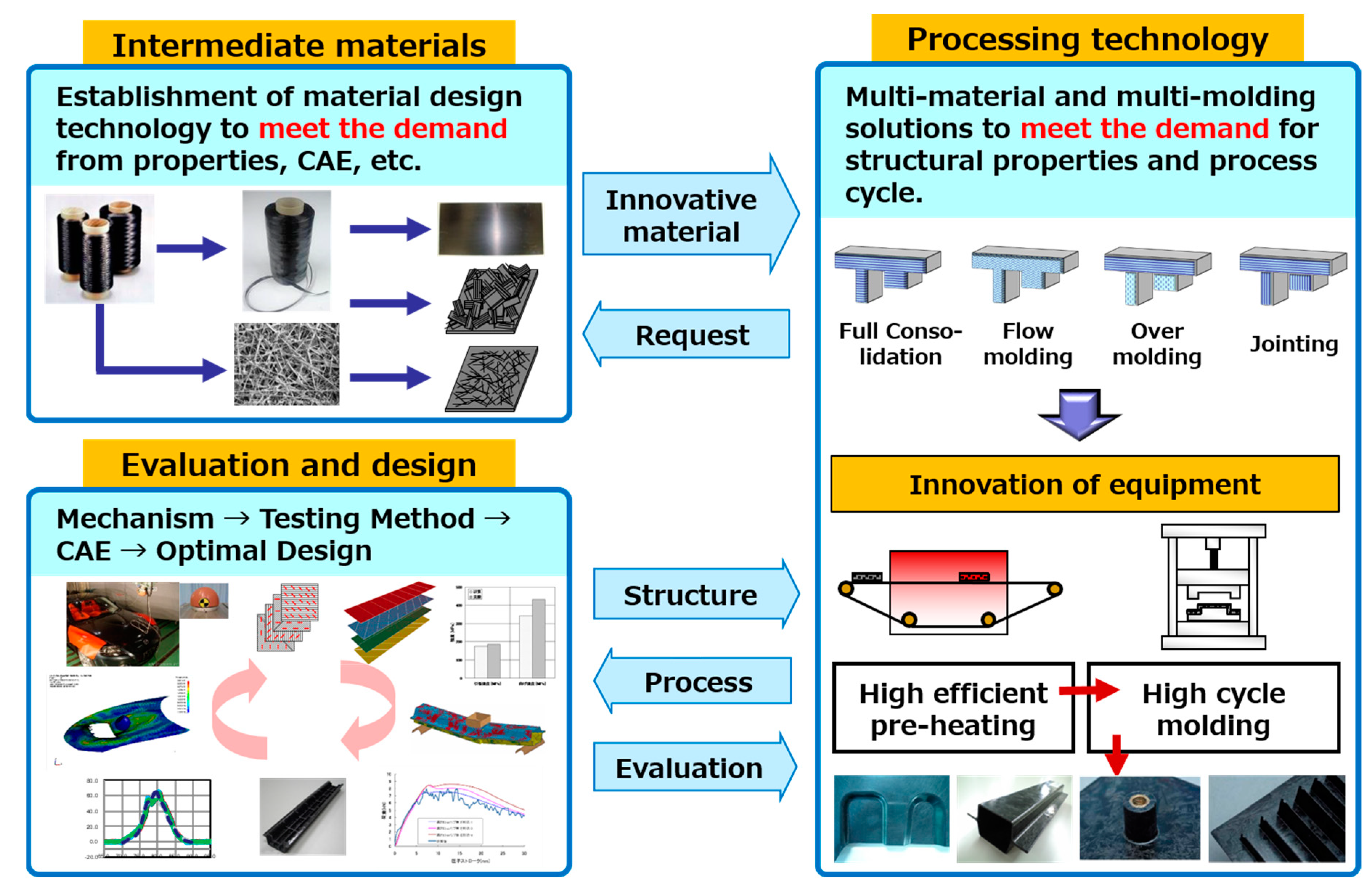

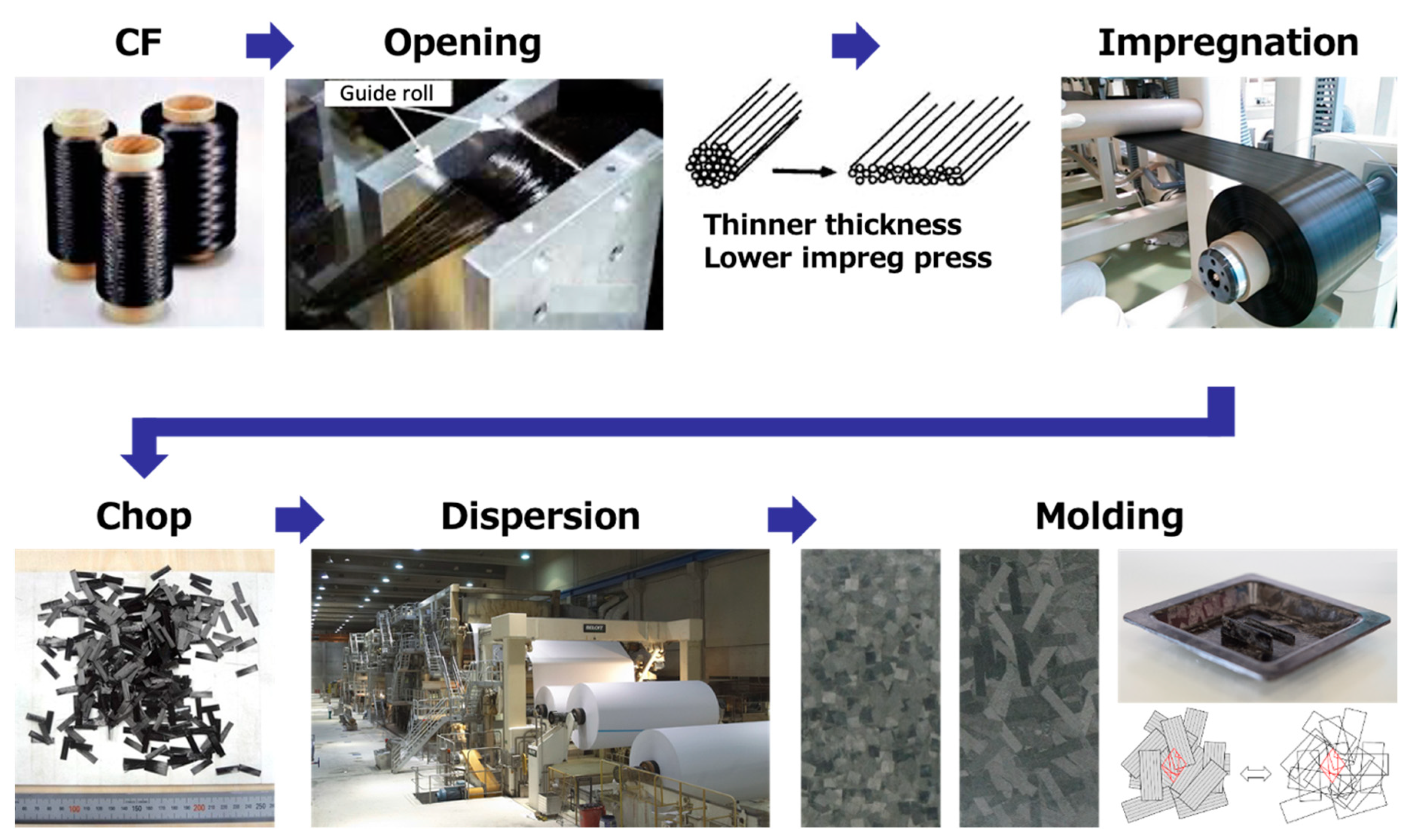


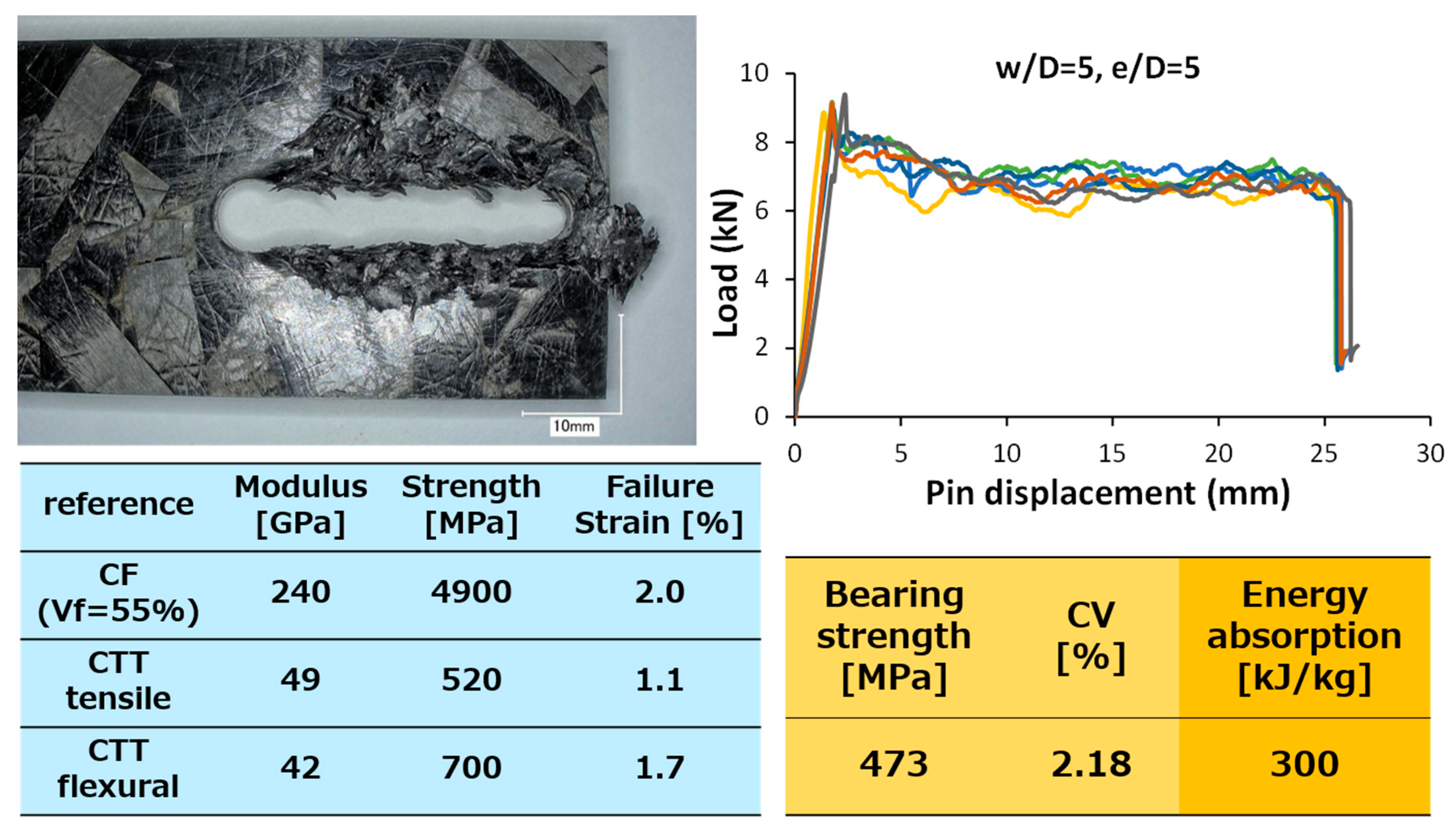


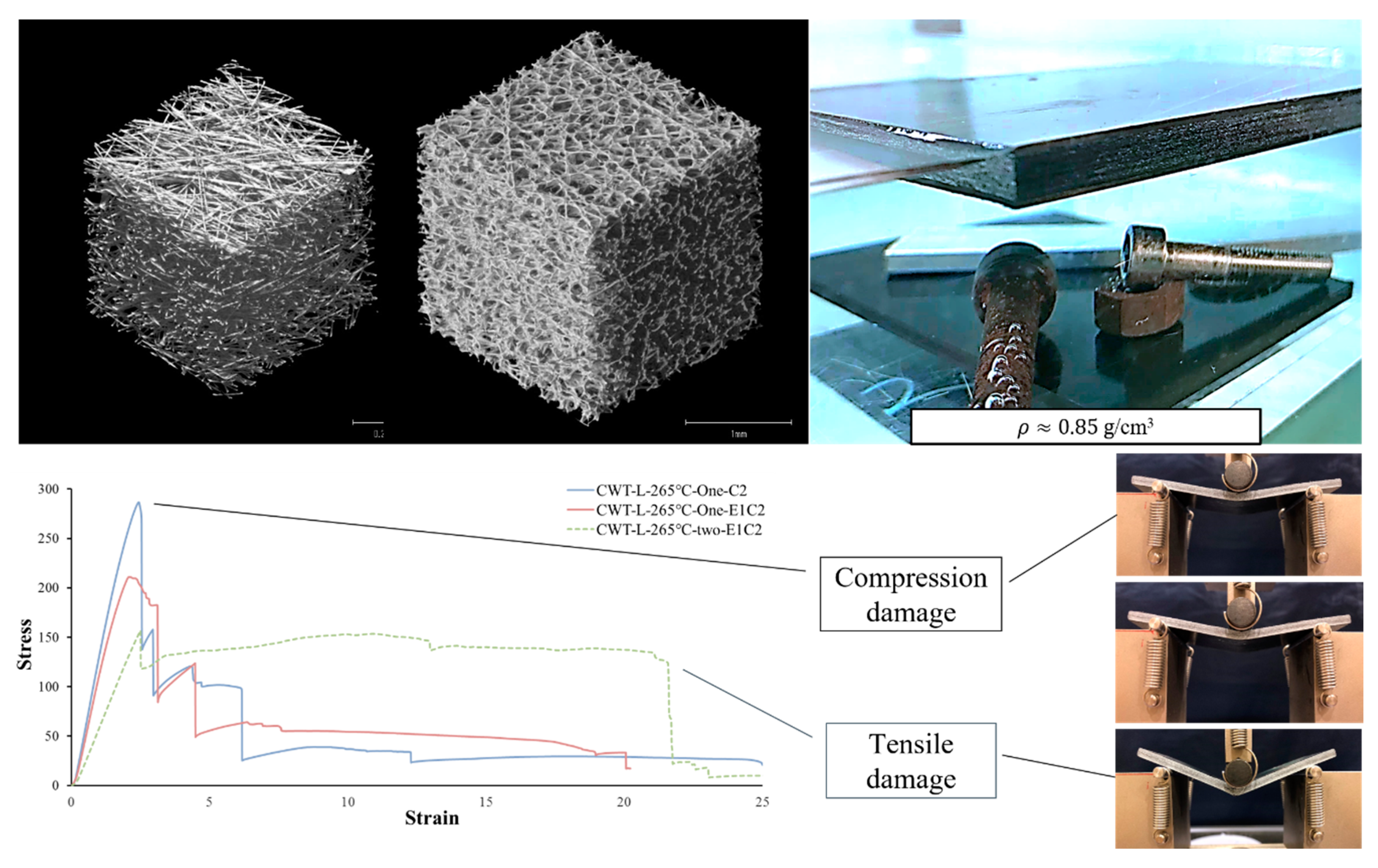
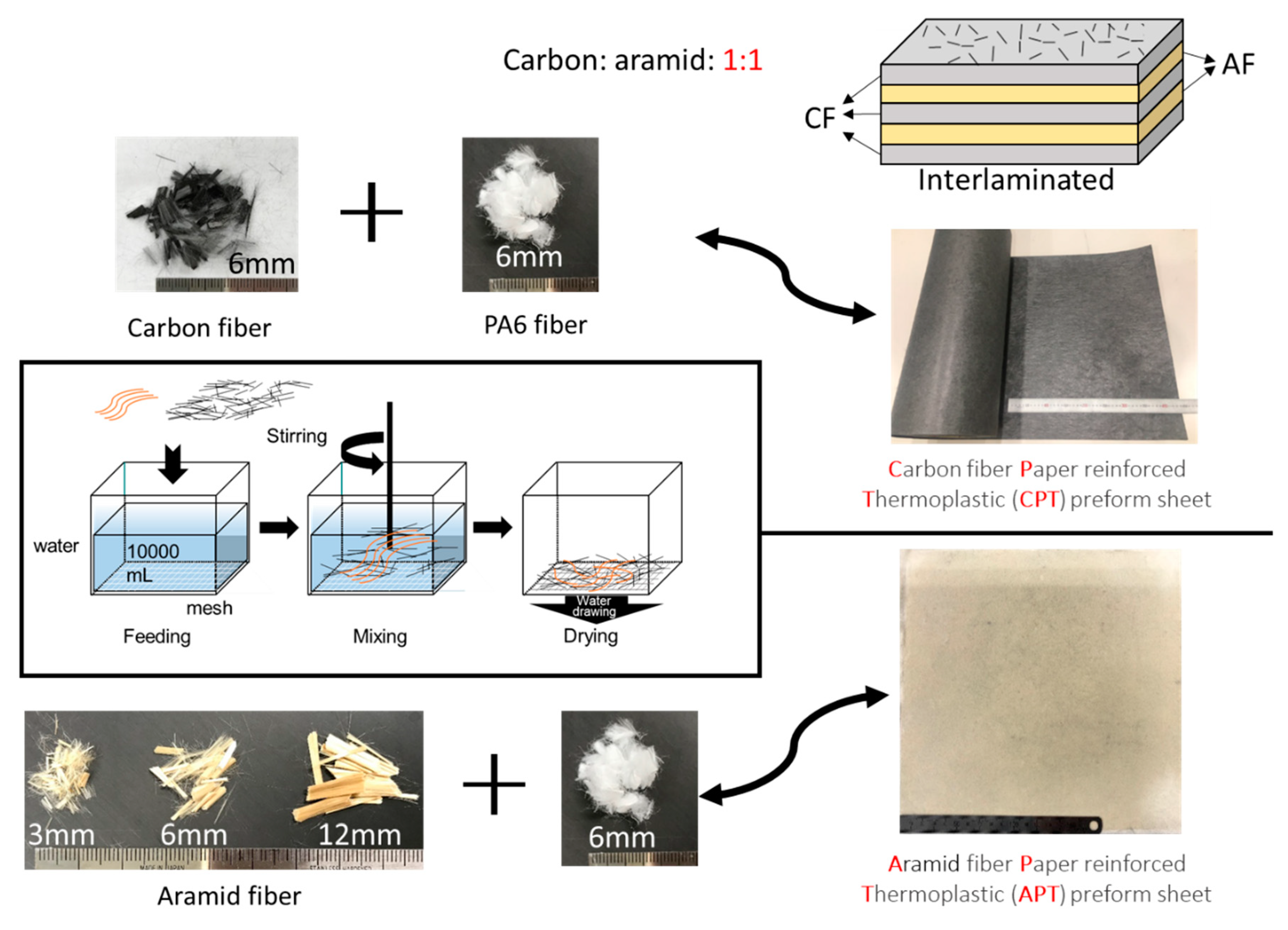
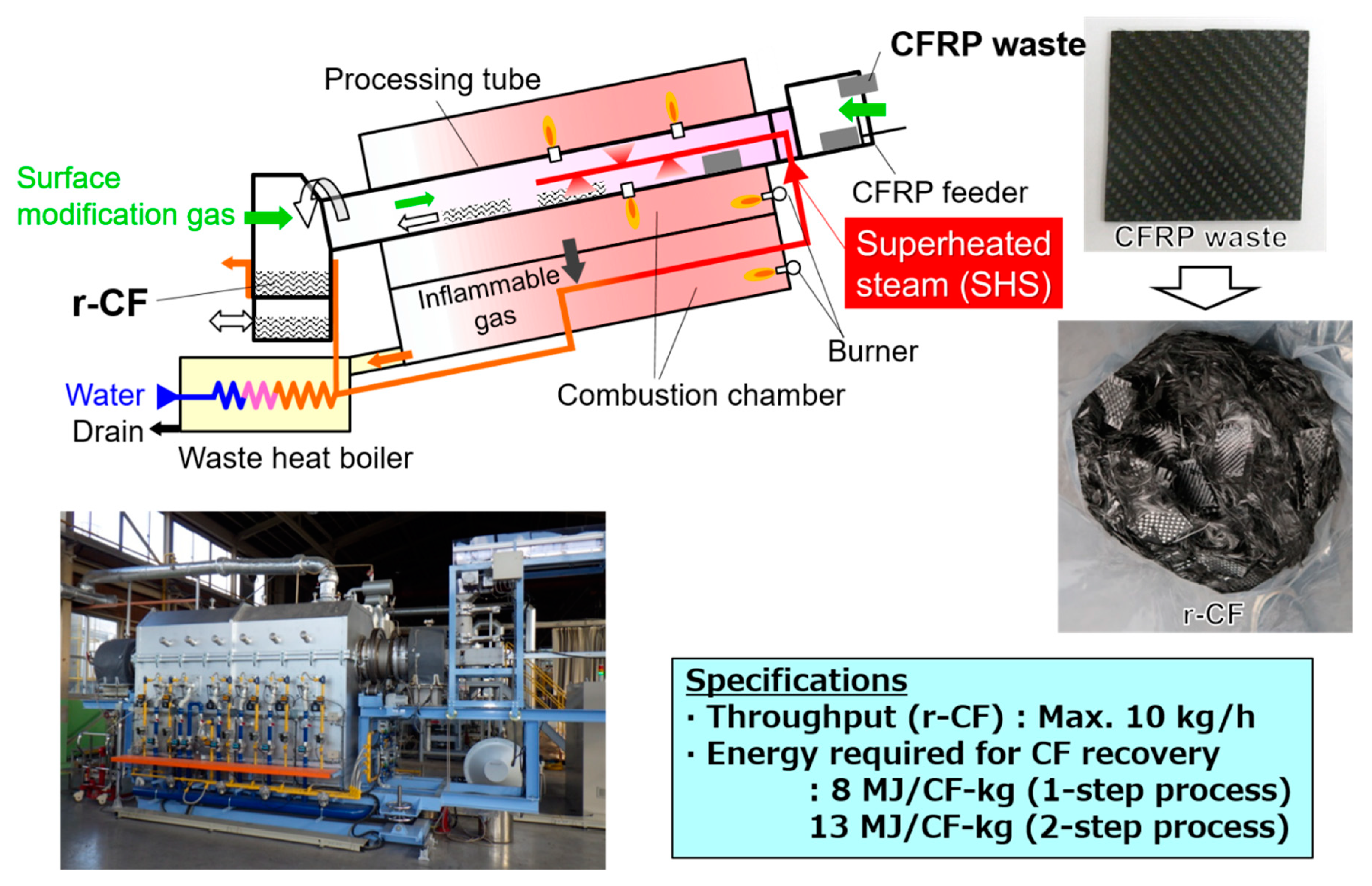

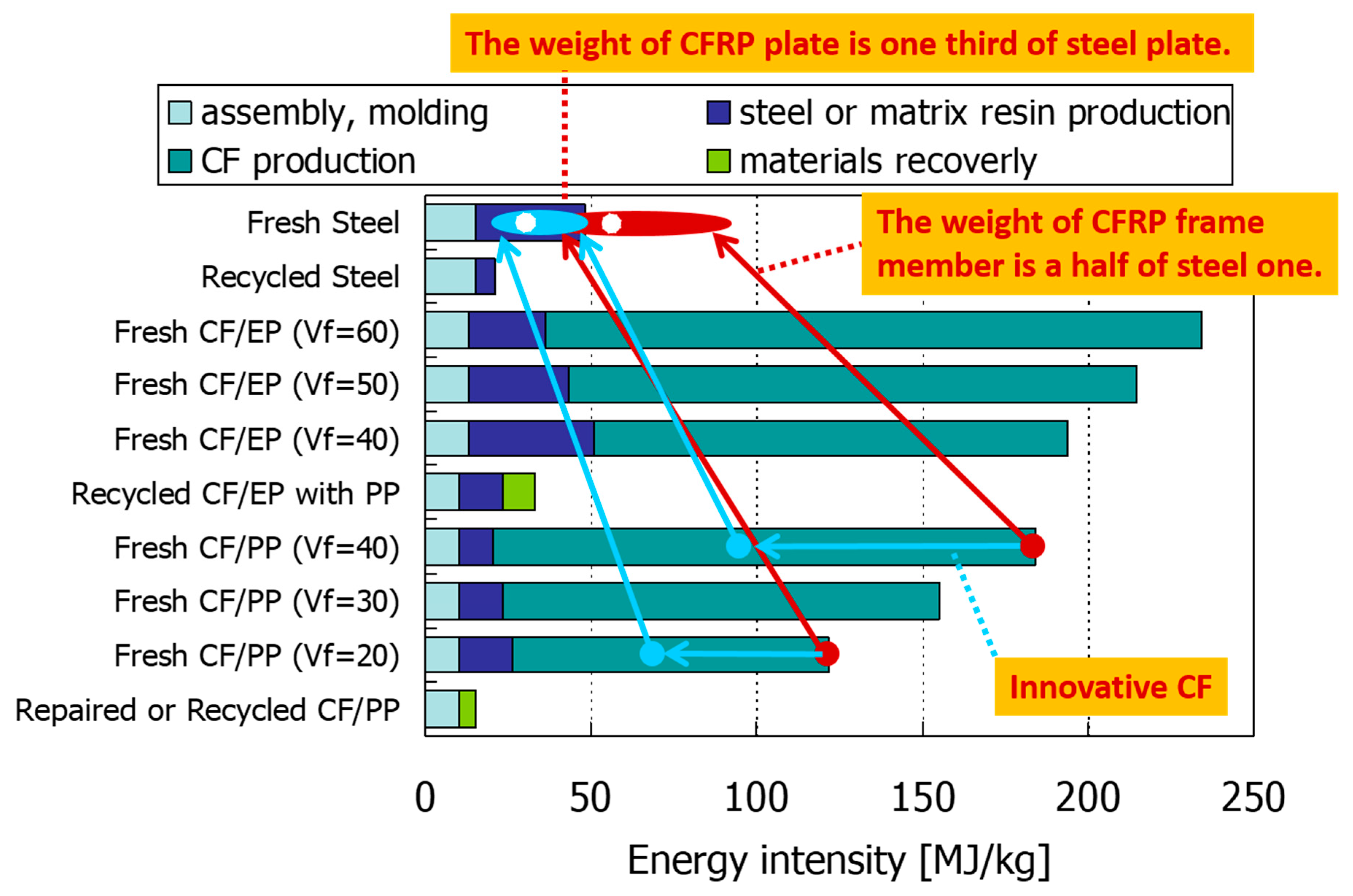

| Pyrolysis | Superheated Steam Treatment | Depolymerization | Subcritical/Supercritical Fluid | |
|---|---|---|---|---|
| Temperature/°C | 500–700 | 500–700 | 100–200 | 250–400 |
| Pressure/MPa | 0.1 | 0.1 | 0.1 | 1–25 |
| Other Conditions | Air, N2 | Steam + Surface treatment Gas (N2, CO2, H2) | Solvent: Benzyl Alcohol Catalyst: Tripotassium Phosphate | Solvent: Alcohol, Acetone, Water Catalyst (subcritical): Alkaline Metals |
| Feature | Air: CF degradationN2: High cost, resin residue | Functionalization is possible | Low cost Functional groups remain Applicable resin is restricted (ex. PP is not applicable) | High investment Low processing efficiency |
Publisher’s Note: MDPI stays neutral with regard to jurisdictional claims in published maps and institutional affiliations. |
© 2021 by the authors. Licensee MDPI, Basel, Switzerland. This article is an open access article distributed under the terms and conditions of the Creative Commons Attribution (CC BY) license (http://creativecommons.org/licenses/by/4.0/).
Share and Cite
Wan, Y.; Takahashi, J. Development of Carbon Fiber-Reinforced Thermoplastics for Mass-Produced Automotive Applications in Japan. J. Compos. Sci. 2021, 5, 86. https://doi.org/10.3390/jcs5030086
Wan Y, Takahashi J. Development of Carbon Fiber-Reinforced Thermoplastics for Mass-Produced Automotive Applications in Japan. Journal of Composites Science. 2021; 5(3):86. https://doi.org/10.3390/jcs5030086
Chicago/Turabian StyleWan, Yi, and Jun Takahashi. 2021. "Development of Carbon Fiber-Reinforced Thermoplastics for Mass-Produced Automotive Applications in Japan" Journal of Composites Science 5, no. 3: 86. https://doi.org/10.3390/jcs5030086
APA StyleWan, Y., & Takahashi, J. (2021). Development of Carbon Fiber-Reinforced Thermoplastics for Mass-Produced Automotive Applications in Japan. Journal of Composites Science, 5(3), 86. https://doi.org/10.3390/jcs5030086





